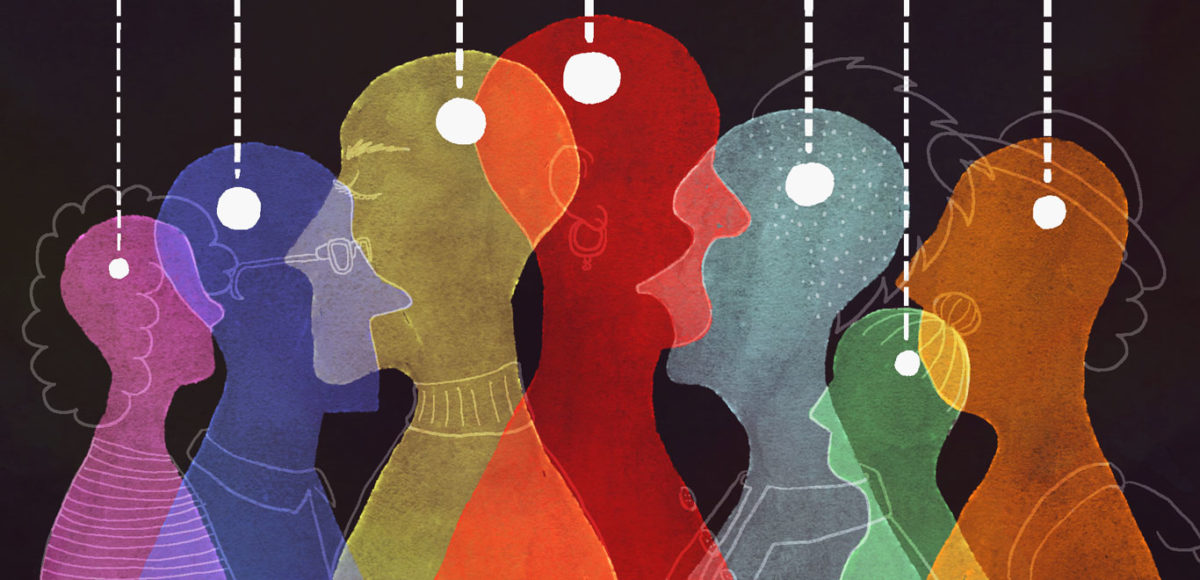Bionic businesses are those that recognise the power of humans and machines working together, with technology augmenting our humanity. Those businesses that think beyond mere automation in this technology age will find significant competitive advantage in a Fifth Industrial Revolution, where humans & machines combine for a better future.
In this first instalment of a series on Bionic Businesses, Graeme Codrington and Buhle Dlamini look into the importance of building businesses that celebrate and amplify different worldviews and approaches, and suggest that Generative AI might assist us in doing this.

Multi-X Businesses
Today’s workplaces are more multi-X than ever: multi-generational (people are living longer, and working older – with fewer managerial bands between older and newer team members), multi-cultural (not just in large multinationals, but even small and medium enterprises often span multiple countries and time zones, or are based in cities that are diverse), multi-lingual (technology is making language less and less of a barrier), multi-gendered (while a few countries are legislating backlashes against the LGBTQI community, most are moving towards acceptance and integration), multi-faith (even in countries founded on a particular religion, we live in an era of unprecedented tolerance, including towards those of no faith), and many other aspects of diversity. We’ve always had diversity of personality profiles, too, as well as different levels of experience, expertise and education.
It is normal these days to work with people who are very different from us in many different ways. In fact, it’s very surprising to come across a team these days that isn’t filled with diversity. This means that we need to be better at understanding and operating in environments that are diverse, overcoming likely misunderstandings, miscommunications and possible confrontations. It is possible to connect across our differences, and many people enjoy doing so, but it takes energy, effort and conscious engagement, and we may sometimes battle with this. We need to develop our ability to do this consistently and consciously.

The business benefits of doing so are numerous, including especially:
- Innovation comes from seeing the same thing everyone else sees, but identifying something different as you do. The more diverse the worldviews involved in an innovation process, the more likely you are to spot the innovation opportunities.
- Adaptability and resilience come from a group’s ability to deal with whatever comes their way. The more diversity we have in the group, the more likely different approaches and attitudes to change, disruption and chaos will assist us in finding a good way forward.
- Customer centricity is an often overlooked benefit of having different types of people in your team. While it is not always necessary to match a customer’s profile with a specific employee, having key customer demographics well represented in your business, especially in marketing, sales and customer service teams, can make a huge difference to customer engagement (or at least stop you making the typos of gaffes that go viral on TikTok).
- Employee engagement, including your ability to attract and retain the best people, and get the best out of them, really does depend on each individual having a sense of belonging and wellbeing in your workplace, which in turn depends on them feeling truly ‘seen’ for who they are.
Diversity is not an ‘issue to be managed’, or ‘a difficulty to be overcome’. Precisely because of the complexity of the world we live in, diversity is, in fact, ‘an asset that should be nurtured’. This involves moving beyond merely recognising differences, and building organisations and teams that are properly inclusive.

Human and machine diversity
If you agree what we’ve said so far, let’s push this a bit further. We believe that the diversity we should be building in our organisations isn’t just about differences between people, but could also include differences between people and machines. By ‘machines’ we don’t mean robots, but rather all the various technologies emerging in the early 21st century, including algorithms, machine learning, the internet of things, quantum computers, and, of course, generative AI (GenAI). Bionic businesses embrace different ways of thinking, and embrace the use of machines to help improve our diversity intelligence.
GenAI was the ‘Technology of the Year’ for 2023. We don’t believe that it is actually ‘Artificial Intelligence’ – true AI (artificial general intelligence) is coming, but is still years away from reality. What we have now now with ChatGPT, Copilot, Gemini, Gork, Claude, etc, are technologies that can access generic and generalised human knowledge and deliver it to us in really good natural language. It has limitations, but it is good for analysing data that we give it, and it is good for helping us summarise information about which we would expect there to be general agreement. And this is where GenAI can help us with developing diversity in our businesses and teams. We will explain below.

A Model for Cultural Competence
In his 2011 book, ‘The Cultural Intelligence Difference’, David Livermore outlines the importance of CQ (Cultural Quotient / Intelligence / Competence). CQ is the capability and desire to function effectively across national, ethnic, generational and organisational cultures. It involves the ability to overcome explicit and unconscious biases and includes the capacity to persist in interactions that are sometimes challenging, even when one feels confused, frustrated, misunderstood or burnt out. Developing a culturally intelligent organisation is about creating an environment where individuals learn about CQ and grow their CQ competence together.
Livermore’s model outlines four practical steps or capabilities to measure, develop and improve CQ:
- CQ Drive: the level of a person’s interest and motivation to learn about and respond to different cultures.
- CQ Knowledge: the quality of a person’s understanding about how cultures are similar and how they are different.
- CQ Strategy: the degree to which a person plans for, remains aware during, and learns and adjusts after multicultural interactions.
- CQ Action: the extent of a person’s flexibility and appropriate use of a broad range of behaviours and skills during multicultural encounters.
These four capabilities can be measured, assessed, improved and developed by individuals and teams. They continue in a loop as improved strategy and actions almost always result in even more CQ drive and knowledge. This is something we can always do more of and always improve upon. It’s something GenAI can help us with.

Step 1: Develop CQ Drive
When you make the effort to learn about a new culture, religion, personality type or any other form of difference (we will just refer to all of these as ‘cultures’ below), these differences become interesting and exciting, and your mind starts to open up to new possibilities. The key is to develop curiosity and empathy as starting points for any engagement with something that is different from your experience or expectations. Asking questions that help your understanding is an obvious starting point, but you can quickly go further by actively immersing yourself in another culture by building friendships, investigating their rituals (food and music are always good places to start), and even by learning a new language. Proactively put yourself into new situations.
Some practical suggestions for doing this include reading books, watching films and talking to people from different cultures to gain a better understanding of their customs and beliefs. When you travel, talk to the locals and pay attention to their habits, behaviours, interactions, foods and holiday celebrations. It is important to remember that to engage with cultural differences, one does not always need to travel. The people we work with represent different backgrounds that we need to navigate daily.
This is where GenAI can be incredibly helpful. Ask whichever GenAI app you have access to help you understand the key defining characteristics of different cultures. You can ask about specifics about customs, food, music, family structures, etc. If you spend some time developing detailed prompts for GenAI, explaining why you’re asking for help and giving information about who you are, you’ll find it gives much better answers. You can also simply ask it to “give more details, and provide specific examples for a business context” if you’re not familiar with prompt engineering. The first goal in develop CQ is to get yourself and your team excited about differences, rather than apprehensive of them.
Of course, we need to be careful about inherent biases in the underlying GenAI algorithms and text engines, but if we want to find out about different cultures, different religions, different personality types and the like, GenAI is as good as a tool as any to do so.

Step 2: Improve CQ Knowledge
CQ knowledge is the degree to which you understand how culture, cultural scripts and systems influence how people, both individuals and groups, think and behave. Cultural knowledge doesn’t necessarily mean that you have to know every detail of a culture. It’s about knowing how that culture in general shapes peoples’ behaviours, values and beliefs. When you understand these cultural factors, the way in which individuals from that culture behave starts to make more sense. This is a natural second step after developing CQ drive.
The dangers of not developing CQ knowledge, and of not having a diversity of different cultures in a team, are fairly obvious, but they become painful when the lack of understanding of differences becomes evident in an organisation’s public communications. This can be especially evident in advertising and marketing efforts that are insensitive to minority cultures.
One recent global example is a haircare and shampoo company that wanted to illustrate that they had hair products for all types of hair and had a series of photos of different types of hair, from straight blond hair to wavy brown hair to curly black hair. The model with the curly black hair was African, and, unfortunately, the label attached to the photo indicated that her hair was ‘difficult’ and ‘problematic’. It’s unlikely that anyone on the campaign intended to cause offence or is actively racist against black people, but this is nevertheless how it was perceived by millions of black people around the world. They might not have realised just how politically charged the issue of discrimination against any of the characteristic of black people is, and so might have approved this advertising campaign with no realisation of how it might be perceived.
CQ knowledge is not developed by accident or osmosis; it is something you should work on deliberately and carefully. A good place to start is using one of the many cultural analysis tools that are available. These include: Wibbeke’s Seven Dimensions of Culture, Hofstede’s Cultural Dimensions, Molinsky’s Cultural Code or Livermore’s Ten Cultural Clusters. Each of these models provides a framework with which you can evaluate your own culture, and then compare and contrast this with other cultures. Try to look beyond the surface of these differences and gain an understanding of ‘why’ different cultures do what they do. As a reminder, GenAI will be able to give you excellent summaries of all these models.
An example of how these models can assist us is to consider one value category that appears in all of them: individualism-oriented culture versus collectivism-oriented culture. One focuses more on individual goals and needs, and the other is more focused on group goals and needs. Depending on where one sits on this spectrum dictates how they prefer to make decisions (individually or collectively), their understanding of ownership (mine or ours) and how they want to be treated (as an individual or as part of a group).
Both authors of this article, Graeme and Buhle, have had similar experiences with individualism vs collectivism, as we have experienced how different countries engage with public health issues. For example, many years ago, a year or so after the H1N1 flu virus had infected hundreds of thousands of people in Southeast Asia, Graeme was doing some work in Hong Kong. He noticed many people wearing masks in the streets and asked his host if they were still scared of contracting the virus. This is an example of an individualistic worldview, where we do things to benefit ourselves. Giving him a puzzled look, his host explained that the people with masks were worried that they themselves had the flu and wanted to avoid spreading it to others (this collectivist worldview prioritises other people above self).

A great place to start in developing CQ knowledge is by understanding your own cultural background and yourself. Read more about your own culture and how it is usually perceived by others. To get better at this requires ‘perspective-taking’, the ability to look at things or your own culture from another person’s point of view. Ask yourself “how do others perceive the way I communicate, show emotions and handle conflict?”. Again, you can turn to GenAI to assist you with this. You will need to do a little but more detailed prompt engineering to get a valuable response from GenAI, but it will be worth it. Use this series of prompts, replacing the [square brackets] with as much information about yourself as possible:
- “Please help me to become more self-aware and develop an understanding of how other might see me, especially in the context of cultural intelligence with reference to [whichever cultural model you preferred from the above list]. I will give you some information about myself. I will then give you an opportunity to ask me some questions to gain a better understanding of who I am. I will then ask you to tell me how you think other people might experience me. Are you ready to begin?”
- Now give your GenAI app as much information as you want to, for example: “I am a [white], [English-speaking], [gender], [age], [nationality]. I have the following [education]. I have done the following [personality profiles], with [these results]. My [hobbies], [musical tastes], etc. Ask whatever questions you’d like in order to get to know me better.”
- Answer each question with as much detail as you can, numbering them using the numbers GenAI uses to ask the questions. Your GenAI will then summarise your answers for you, maybe describing you in ways that resonate deeply with you.
- You can then ask GenAI: “How might other people struggle to understand me, or be frustrated by the way I communicate, show emotions and handle conflict?”
- “Which cultures and types of people might find it difficult to work with me? And how could I work to overcome these difficulties?”
The time and effort you put in to create this prompt will be rewarded with a wonderful analysis of who you are and how others might engage with you. Note that in most GenAI apps you can save this conversation, and come back to it later, asking GenAI to help you with a specific issue or relationship. It will then use all of this knowledge about you as a template for giving you very personalised coaching advice.
Of course, don’t just rely on GenAI. Seek out opportunities to have real interactions with real people from other cultures, whether in person or online. Travel, work or volunteer in another country. Join a club or group that celebrates diversity. Remember that although some cultural expectations are subtle and nuanced, others are completely clear – they might even be spelled out in formal policies and laws.
The main threats to your CQ drive are stereotypes, prejudices and discrimination. Stereotypes refer to beliefs that certain attributes, characteristics, and behaviours are typical of members of a particular group of people. Prejudices refers to feelings and attitudes towards a group and its members. Discrimination involves differential treatment of members of a particular group. We overcome these barriers best when we connect with individuals, applying a curiosity mindset and being open to differences.
You can ask GenAI to help you identify unhelpful and damaging stereotypes and prejudices. You can even ask GenAI to act as your personal coach and give you suggestions of how to overcome any of these stereotypes and prejudices you might identify in yourself. If your team is willing to share the CQ issues they’re working on, you can even ask GenAI to suggest discussion guides and activities that you can work through together as a team to assist in overcoming these.

Step 3: Develop a CQ Strategy
When you are culturally aware, you can use what you have learned to formulate robust, culturally-sensitive strategies for yourself, your team and your organisation. CQ strategy is the capability to take our CQ drive (motivation) and CQ knowledge (awareness) into consideration when interacting with those who are different from us. The goal is to be better prepared for cultural differences and to learn to value and enjoy these interactions. CQ strategy involves awareness, planning and checking, before, during and after interactions.
For example, if you are a manager, when you communicate with your team do you take the time to plan the manner, style and content of your communication, specifically taking cultural differences into account? Having a high CQ strategy means that we plan our communications (emails, memos and even texts) before sending them, by thinking about the differences of the audience and making sure you don’t cause offence or misunderstanding. This is where GenAI really comes into its own. You can use the template you created above, and input an email, a memo or a meeting agenda, and ask GenAI to help you make it more culturally intelligent.
Developing a culturally intelligent organisation or team requires a conducive culture for inclusion to take place. CQ strategy plays a key role in creating inclusion in our teams, because it requires us to think about the differences that exist and be aware of, plan for and check that these are catered to. The key characteristics of a culturally intelligent environment are:
- Trust – Trust is easier to achieve when people have similar backgrounds and value orientations but harder when diversity is a factor. Therefore, leaders need to know how to build trust among people with different value orientations by promoting understanding of each other’s differences.
- Engagement – Team members from culturally intelligent organisations are more fully engaged in their work. When you work at a place where your manager understands how to motivate you, gather your input, and support you to do your job, it drives you to be far more productively engaged. When you interact with team members who value what your different perspective offers, it causes you to lean in and speak up boldly. Good communication is essential for successful cross-cultural interactions. Learn how to effectively communicate across cultures, making sure you are clear and concise in your communication while being aware of potential language barriers.
- Authenticity – A culturally intelligent organisation is a place that encourages people to be comfortable in their own skin while learning which behaviours and procedures need to be adjusted when working in a diverse environment.
- Positive Intent – Psychologists say we are naturally inclined to view others suspiciously. When working in diverse teams, our differences can often lead to unconscious biases. Culturally intelligent organisations create a culture of positive intent by equipping managers and associates to be committed to assuming the best first. They are places where people stop to consider whether ‘inconsiderate behaviour’ might be a result of a cultural difference before assuming something else is going on.
Thinking that ‘your’ way of doing things is ‘normal’ and ‘the correct way’ is the most common mistake people make. To be successful in cross-cultural interactions, you need to be open-minded and willing to accept that there are different ways of doing things. Don’t try to force your own culture on others – instead, learn about their culture and try to see things from their perspective.

Step 4: CQ Action
The last element of CQ capabilities relates to how you behave and, in particular, how you react when things don’t go according to plan. One of the most important aspects of cultural competence is flexibility. Things will not always go as planned in cross-cultural interactions, so you need to be able to adapt and adjust accordingly and demonstrate by what you do that you are committed to cultural competence.
CQ action is the behavioural aspect of cultural competence, turning our CQ drive, CQ knowledge and CQ strategy (planning) into culturally sensitive behaviours when interacting across cultures. An example of CQ action may be making adjustments when interacting with someone who has a different communication style from yours. If someone in your team has an indirect communication style whereas yours is direct, by applying CQ, you may practise more patience when they take longer to get to a point, and you may even choose to engage in more ‘small talk’ than you would normally do in order to make them feel more comfortable. It’s not only about spoken communication, it can also involve gestures, dress code and other expressions that show that you are respectful or considerate of others’ differences.
In our teams and organisations, we can take the following practical actions:
- Celebration of cultural events: Encourage the celebration of different cultural events within the organisation. This not only educates but also shows respect and appreciation for diverse cultures.
- Cultural learning sessions: Organise regular cultural learning sessions where team members share insights about their cultural backgrounds and cultures they are familiar with. These can double up as team development sessions. Remember that cultural diversity also includes generational diversity, as young and old people even from similar backgrounds see the world very differently these days.
- Role-Playing Scenarios: Implement role-playing exercises that simulate cross-cultural interactions. This practical approach helps team members anticipate and navigate potential cultural conflicts or misunderstandings.
- Inclusive communication guidelines: Develop and disseminate guidelines for inclusive communication. This includes being mindful of cultural nuances in language, non-verbal cues and meeting formats.
- Feedback mechanisms: Establish open and safe channels for feedback related to cultural misunderstandings or biases. Encourage team members to voice their experiences and suggestions. It is much better to do this more regularly addressing small misunderstandings than to leave issues festering until they explode into major confrontations.
- Mentorship Programmes: Pair team members from different cultural backgrounds in mentor-mentee relationships. This promotes cultural exchange and personal connections within the team.
- Continuous Learning Resources: Provide access to resources such as books, courses and seminars on cultural intelligence.
- Diverse team composition: Actively create diverse teams for projects. This not only brings different perspectives together but also encourages team members to adapt and learn from each other in real-time.
GenAI can be useful in helping your come up with many different ideas of how to do the above actions with your team, and can spark your brainstorming with your team to add to this list creatively.
By integrating these actions into your team’s routine, you will cultivate an environment where cultural competence is not just a concept, but a living reality that enhances teamwork, creativity and overall performance. Ideally, the CQ drive of your team will be improved by these actions, and you will continue to improve cultural competence in yourself and your team.

Conclusion
Creating a culturally competent team or organisation is much more attainable today than ever before. By using a proven framework that has been used by countless organisations globally, and using GenAI to assist, you can position yourself for success. CQ can help you and your team to leverage the differences that different people bring to your organisation. When you lead with cultural intelligence, you create an environment that promotes understanding, openness and authenticity in the workplace. By helping your team understand that it is their differences that make them and you well positioned to succeed in a diverse and global marketplace, you set yourself and them up to thrive!
Graeme Codrington and Buhle Dlamini are partners in the Strategic Insights firm, TomorrowToday Global, and both have a passion for the future of work and people. They help teams and organisations to prepare for the challenges of an ever-changing world. Graeme is based in South Africa. Buhle is a certified CQ Intelligence coach and is based in Nova Scotia, Canada. They can be contacted via https://www.tomorrowtodayglobal.com.






Trackbacks/Pingbacks